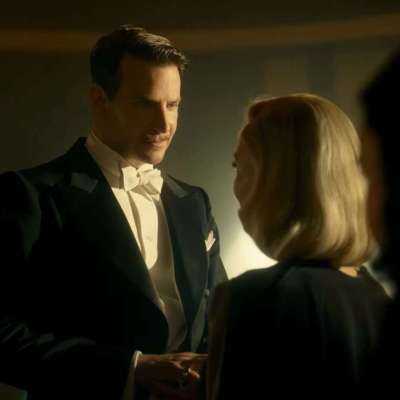Nightmare Alley (2021) vs. Nightmare Alley (1947): What Are the Differences?
Guillermo del Toro puts his mark on an occult cult classic, finding the monster in Nightmare Alley and filming him in a different light than in the original 1947 movie.
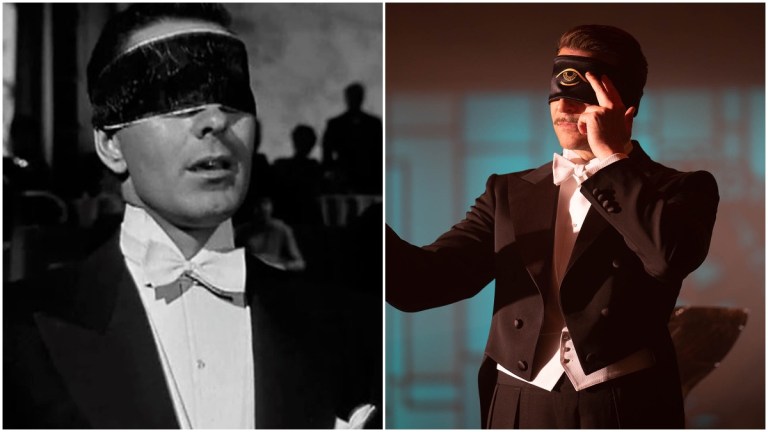
This article contains spoilers for both versions of Nightmare Alley.
“Mister, I was made for it,” versus “Mister, I was born for it,” sums up the major psychological distinction between the 1947 Nightmare Alley and Guillermo del Toro’s 2021 remake. Neither line from the end of their respective movies is in the 1946 novel by William Lindsay Gresham. That book concludes just short of the revelation or confession (depending on the actor who says it). Bradley Cooper’s Stan Carlisle finds it downright hilarious that he is about to become a geek. Tyrone Power’s The Great Stanton only grants himself temporary clemency. The geek is their destiny. Chicken necks are their shared fate.
The first major difference between the two movies is the most obvious. One employs all the tricks of black and white filmmaking, the other shades its colors in a muted noir. The next immediately recognizable difference comes at feeding time. We see the chicken’s neck ripped apart in full gory color in the new film. The older film cuts away as the fowl is unceremoniously dumped into the fenced-off pit for gawkers to revile.
Here we look at some of the glaring and subtle differences between the two adaptations of the noir classic, Nightmare Alley.
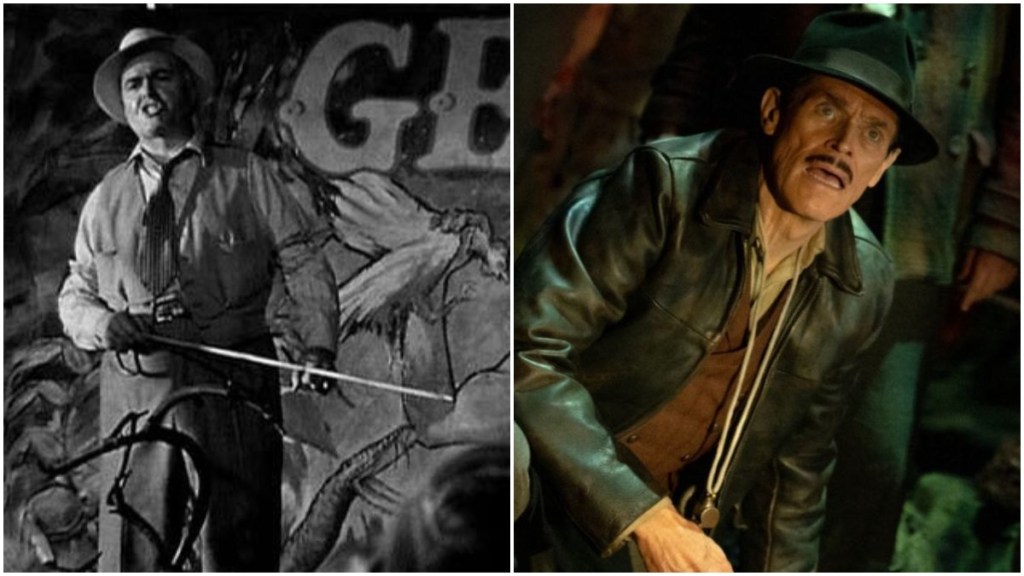
Geek Show and Carnival Life
Directed by Edmund Goulding at the height of the Hays Code, the original Nightmare Alley could only tease the grotesqueness of the geek attraction. Del Toro keeps his camera focused unblinkingly on the brutality, savagery, and pain inflicted on the performer, underscoring the conditions of the traveling world endured by carny folk.
The geek act represents rock bottom. The lowest rung of society and entertainment, the geek swallows snakes and bites the heads off live chickens for the crowd’s amusement and repulsion. In the original 1947 screenplay by Jules Furthma, the character of Clem Hoatley (James Flavin) refuses to talk about the geek, telling Stan, “When you’re around this carny longer, you’ll learn to quit asking questions.” The new and eager employee who is our protagonist gets his answer instead from the fortune-teller Zeena Krumhein (Joan Blondell), who explains, “That’s always a sore point in a carnival. The geek is one of our biggest draws, but a lot of performers won’t work a show that carries one.”
In the new film, the carnival manager, Clem Hoatley (Willem Dafoe), has a much larger role and details the process of turning alcoholics into geeks: You don’t find them. You make them. You pick up a bottle-a-day boozer at the end of his rope, tell him about a little job acting, only temporary until a real geek comes along, give him a dry place to sleep and a bottle with a drop of something extra, and he’ll think he’s gone to heaven. When he’s hooked, you threaten to fire him. He thinks about sobering up and getting the crawling shakes which come with detox. Throw him a chicken and he’ll geek all over its throat.
The dialogue in the 2021 version is almost verbatim from the source material, except there is no overt mention of spiking the alcohol with opium in the novel. Del Toro and his co-screenwriter Kim Morgan stick to the “blueprint,” and in their interpretation, Stan’s big realization is that he was born to it. It is actually liberating for him because he was always beyond hope and can now take off his mask. Tyrone Power’s Stanton deteriorates into the geek. He is made to choose his doom. Cooper never had the choice.
Stanton Carlisle’s Backstory
When the 1947 film begins. Stan is already working at Hoatley’s Ten-in-One show. The only thing we know about his life before the carnival is when he admits he is an orphan who spent time in reform school. It might be a con or a romantic invention, Power pushes a touch of ambiguity into the read, but his eyes also betray innocent confession. Del Toro introduces a subplot about Stan’s history with his father, and with alcoholism, which strips any semblance of a naive origin. Cooper’s Stan has a troubled relationship with his father, which ends coldly. This Stan is less innocent from the beginning.
In the 2021 version, Cooper’s Carlisle burns right into the action. He’s tossing a bagged body under floorboards and torching the house over it. He takes a bus to its last stop and follows Major Mosquito (Mark Povinelli) to the carnival, which will be his deliverance, no questions asked. This shades and foreshadows Stan’s backstory, and establishes a pattern of rushed forward motion with only one eye merely glancing at the rearview mirror. He starts off as an outsider to the outsiders, and claws his way to ultimate outsider. By contrast, Power’s Stanton begins loving the carny, the crowds, the noise. He’s had a lot of jobs, but “this one gets me.” He could have been part of the family.
The traveling family in the original film is complex. Their relationships are shaded and tangled, but loving and protective. Goulding’s direction features ensemble acting, which better fits the theatrical settings of the tent carnies. The first half of the film takes place in a world of live entertainment, and the actors dance off each other.
Both Mike Mazurki in the original film, and Ron Perlman in the remake, allow the strongman Bruno to bear the brunt of not being able to hold the family together, and arranging the shotgun marriage which tears it apart. Mazurki was a Hungarian wrestler before he became a reliable character actor, and Perlman is as likable and intimidating as his predecessor. Their roles are similar, and they bring an earthy class to both films.
Del Toro focuses squarely on Cooper. It is his film. The other characters are brushed off into more isolated scenes to keep Carlisle in the spotlight. We are rooting for him as he and his wife Molly (Rooney Mara) run off to do nightclubs as a headlining spiritualist act. We worry when he promises wealthy clientele he can communicate with the dead, knowing spook shows are treacherous.
Power isn’t even always center stage in the framing of the original film. Stanton is figuratively relegated to the archetypal femme fatale of the era, climbing the ladder of success one woman at a time. Even as the original Stan is promising to make Molly (Coleen Gray) happy, he’s only got eyes for the future. He doesn’t see her. He only sees the money they’ll make.
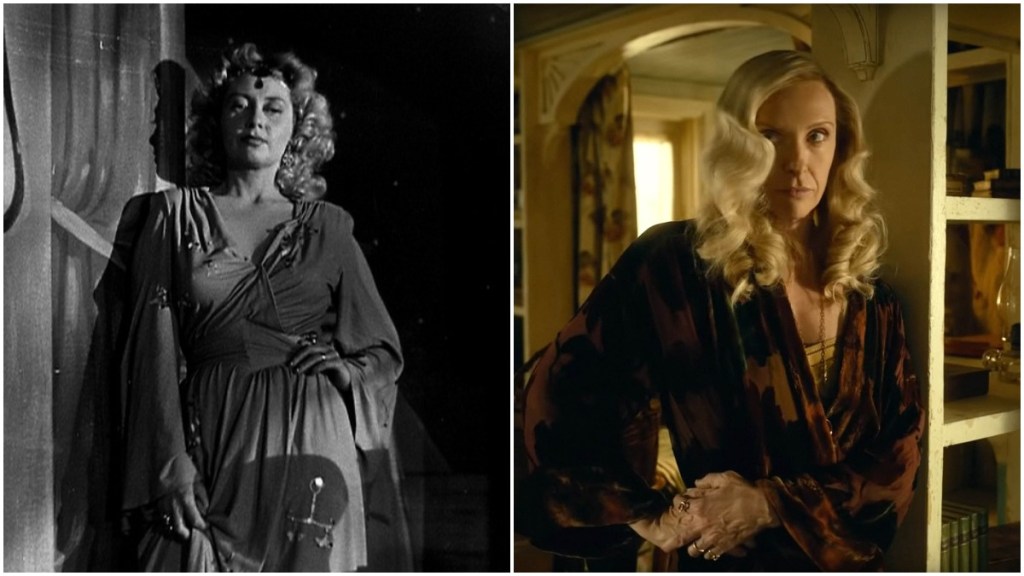
Pete and Zeena and the Secret Code
The 1947 film adaptation was forced to limit Stanton and Zeena’s affair to a few arm kisses, a caress, and a visual distraction. The remake’s Zeena, an alleged medium and seer, is played by Toni Colette as more up front. She declares Stan is “easy on the eyes,” has a kind of panache, and one-tenth of a dollar only gets so much soft soap. She’s a little more wary of the new hire’s ambition than Blondell’s fortune teller, but cuts him some slack, mainly from the bottom of the deck.
The science of tarot reading is far more detailed and revered in the 1947 film. Blondell’s Zeena gives a full rundown on the cards, their placement, relation, and the significant variations on whether they are pulled by hand or land by fortuitous accident. The novel is laid out as a tarot spread, each chapter is named for a card in the Major Arcana. The ease with which these cards repeatedly foretell downfall in both films is a little too Hollywood, where the death card is always literal. Both Collette and Blondell’s Zeena genuinely believe in the power of the cards. The sideshow soothsayer may be a fake in everything else, but pentacles, swords, aces, and wands are a language to her.
In the original film, Zeena admits she’s “about as reliable as a two-dollar coronet,” but her belief in the tarot is so committed, no one questions her predictions until Stan accuses her of stacking the deck to con him. Nonetheless, the card gets under Stan’s skin, whether the deal is real or underhanded. He is powerless against its venerated status. Stan knows the cards will always tell the truth. He’s been trained to respect them. In the updated version, Stan dismissively flips the reversed Hanged Man over. “There, I fixed it,” he sneers.
In the 1947 film, Pete (Ian Keith), a one-time headliner now a broken drunk, is protective of his mentalist secrets, especially “The Code,” the system of words and correlative numbers he and Zeena use to read minds while blindfolded. The film follows noir fatalism, sees class as predetermined, and booze as the great leveler. Zeena and Pete made the big time but got kicked back down to the life of a traveling carnival, where they belong.
The psychic scam codebook is the key to Pete’s retirement. He is very upset when Stan brings it up to Zeena in the caravan. She later considers selling the code in order to pay for Pete to get “the treatment.” This is problematic when Stan intentionally leaves the poisonous wood grain alcohol for Pete to drink. Power’s ambitious grifter has more motive to get rid of the man who invented and perfected the system.
In the 2021 version, Pete (David Strathairn) mentors Stan. He is bubbly and bright, speaks French, and knows his way around high society. The pair bond, and even as Stan is going behind his back, there appears to be genuine affection, and true respect. Pete becomes a father figure to the enthusiastic pupil. But it’s already been established that Stan’s got daddy issues.
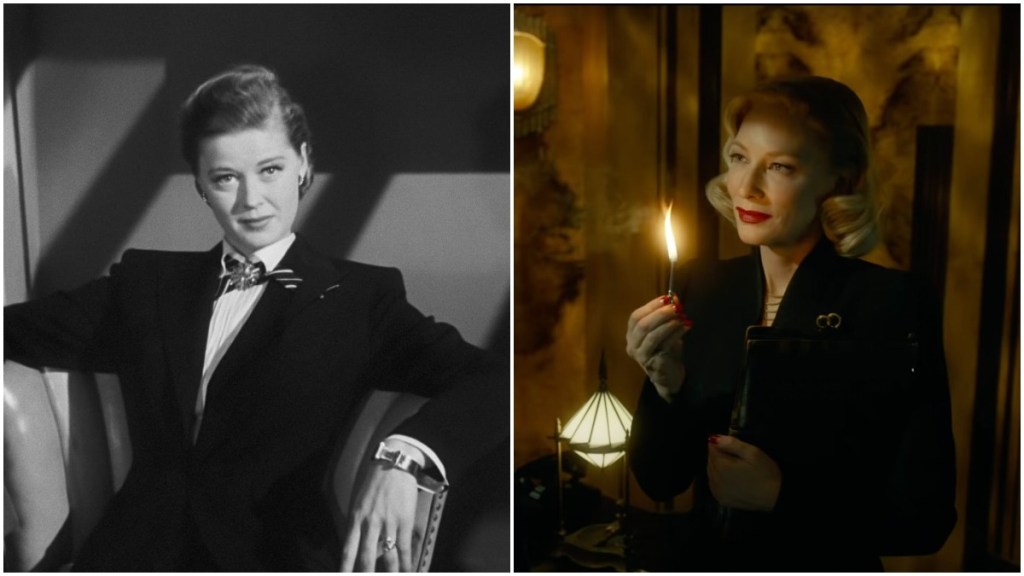
The Fatalism of Dr. Lilith Ritter
Dr. Lilith Ritter (Helen Walker) is a secondary character in the original film but she still has one of the most finely drawn female depictions of evil in post-war cinema. After reaching the highest realms of Chicago society a mentalist in the spiritualism racket can reach, Stanton connects with Lilith because “a con artist knows a con artist.” The most fatale of all the femmes, the consulting psychologist character pulls the most devious bait-and-switch in both films. She has the mind for it. In the book, her brain is “always hooked to his own by an invisible gold wire, thinner than spider’s silk. It sent its charges into his mind.”
The 2021 film expands Stan’s psychoanalysis sessions, and allows Cate Blanchett to fill Dr. Ritter’s inscrutable personal space, both inner and outer. Both movies create an atmosphere around the character which subliminally implies something hidden beneath the surface, the very definition of occult, and the new film allows her to plunge deeply. The sessions border on regressions, as the doctor brings the unwilling patient into the very moments of his trauma.
The expansion also gives Cooper more screen time with Blanchett, who nakedly reveals her character’s deepest damage and uses it as a huckster’s hook to lure him into a revenge con. As a psychologist, Dr. Ritter knows what Stan is all about and doesn’t need anything from him. She has social standing, money, and the most inside of information. She knows Stan is a con artist even if he can guess the caliber of her nickel-plated pistol. When Lilith swaps his cash bundles for single-dollar bills, she’s not just stealing legal tender. Stan’s money is his soul.
Blanchett’s Lilith is as terrifying and inhuman as the dark biblical figure she is named for. In some ways, she is the snake in the garden for this movie, or, as she says, “am I overselling it?” Lilith is more directly involved in Stan’s downfall too because she is the best bait. She has him at: “I know you’re bad, because so am I.” It is a shame, however, that their final confrontation is done physically in an action sequence. The original film does it with dialogue and silence, shades and ever-cramping spaces.
The new film brings masochism to the sadistic Lilith, as Blanchett revels in the moment her prey realizes he is in a trap. Walker’s Dr. Ritter would never let Stan see any of that satisfaction. She just tells him to go home, and even as he’s running out the door, he is doubting who he is, losing his rationale, almost geeking out.
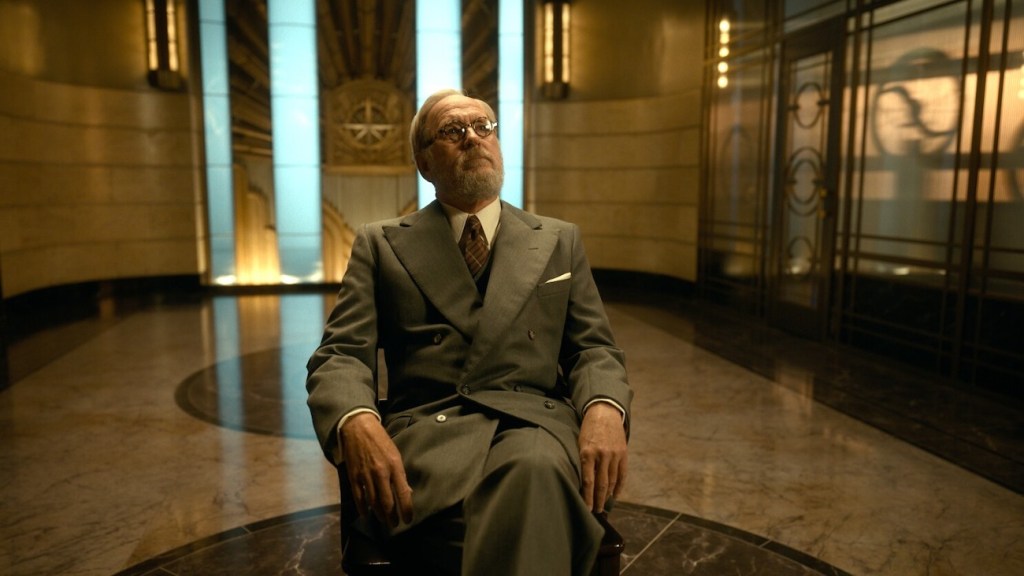
The Old Money of Ezra Grindle
Del Toro’s film is 40 minutes longer than the original adaptation, and allowed to more deeply explore plot points in the Gresham novel. The ultimately suicidal search Judge Charles Kimball and his wife Felicia (Mary Steenburgen) conduct for their dead son is not in the original film. Besides the overt gore, the 1947 version had to drop references to adultery and abortion. Ezra Grindle (Taylor Holmes) is just a mark to Power’s high society prognosticator, and this is just his biggest parlor trick. The climactic materialization session looks like it’s going to work until Coleen Gray’s Molly breaks character in a fit of guilt. In the new film, Molly keeps up the charade of spectrally impersonating the deceased Dorrie, even though she’s had enough. It’s the mark who breaks the pattern.
The 1947 film also skips the details on how Dorrie died, and the depths it drove her grieving boyfriend. Ezra is just a wealthy businessman suffering personal loss and seeking solace when Stan forces him to his knees and fleeces him in the first movie. In the 2021 version, Ezra Grindle (Richard Jenkins) is a monster, a true del Toro masterpiece. Ezra wants to wash his soul, and thinks he can do it in cash. His sins are far darker, and his entitlement too secure. His wealth has afforded him a lifetime of retraumatizing his dead bride. It is implied he is a serial rapist, and possibly a murderer, who preys on any woman who reminds him of his lover, including Dr. Ritter, who has set Stan up to exact her revenge.
Del Toro also gives Ezra a right-hand man, Anderson (Holt McCallan), who is the Head of Plant Security in the book, and who pegs Carlisle as a huckster straight off in the movie. The film implies there is an interesting tale behind his loyalty to Grindle.
The Ending
Del Toro’s conclusion is faithful to the book, almost to the word, except for the shared line which defines both adaptations. Del Toro mischievously personalizes the setting of the last scene, bringing attention to Enoch, the prized curio of treasured grotesquery. There may come a day, when Stanton can end up in a jar like that. Cooper’s character would love that. His interpretation is enshrined in a long shot of utter despair, after being the only one in on the best joke he’s ever heard.
Born or made, Cooper’s Stan is the geek in flesh, one carny to another. Mentalism is old fashioned, and the former headliner has been dodging the fallout of the spook racket for far too long. He came from society’s outer fringe, traded in the watch he stole from his dad for a shot of the booze he swears he “never” touches, and chicken blood is starting to look good. Psychic readers never see what’s coming to them, a sucker is born every day, and Stan is just another chump. He’s only actually taken two jobs in his life, and it doesn’t look like this one is temporary. There won’t be another geek to come along and take his place. It was always his fate.
Director Goulding was forced to add an additional scene to the 1947 film in order to give the appearance of some kind of happy ending. Power’s Stan breaks under the pressure of being a geek. He looked at that shot glass just as eagerly as Cooper’s broken rummy, but he tries to get out. He was made for it, mister, not born that way, like the guy who sang with Lady Gaga. In the final scene, Power’s Stan is like the monster caught in the alley in American Werewolf in London. But instead of being killed by angry carnival workers, Molly talks him down, and promises to take care of him. Even the darkest noir films of the time had to give the appearance of possible redemption.
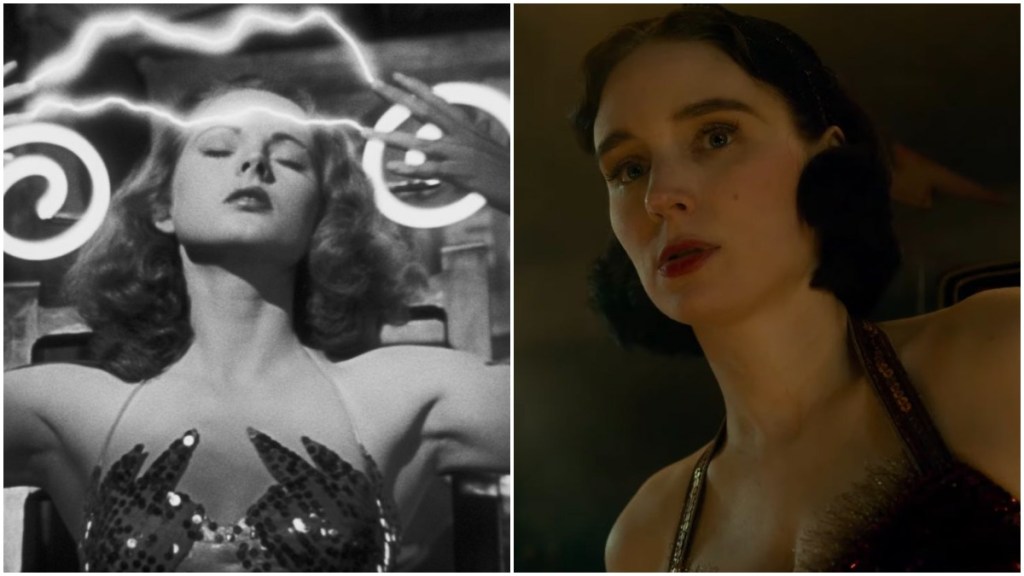
Period Piece vs. Contemporary Film
The original Nightmare Alley was made a year after the novel became a notorious hit. It was a contemporary story. Del Toro’s film is a period piece, which begins in 1939 and mirrors the buildup to World War II. Goulding was a versatile filmmaker, directing comedies like Everybody Does It, war movies such as The Dawn Patrol, romances and family dramas. He took on psychiatry for The Flame Within, and explored esoteric spiritual quests in The Razor’s Edge. While he wasn’t nominated for Best Director, his film Grand Hotel won the Oscar for Best Picture. A hands-on filmmaker, Goulding co-wrote scripts without credit, composed incidental music, and was an authority on developments in wardrobe, hair, and makeup for motion pictures.
For Nightmare Alley, Goulding was influenced by post-war Italian cinema. His noir classic is a neo-realism film which was hobbled by Hollywood censorship. The del Toro film is free to wallow more graphically in the nihilistic immorality, and is a full cinematic experience. Nothing in the 2021 film plays out in real-time, the camera moves, action overtakes suspense, and Nathan Johnson’s soundtrack is impressive, possibly his best. Goulding shot in a documentary style, with long static settings, and Cyril Mockridge’s score is exquisitely minimalist.
Del Toro is a modern master. His Oscar-winning films, Pan’s Labyrinth and The Shape of Water, are timeless classics with vastly divergent visual and storytelling approaches. Pacific Rim and Crimson Peak indulged inventive genre boundary-pushing. Del Toro brings spectacle to Nightmare Alley when it’s really a “one-in-ten” tent show. This makes the underlying subterfuge too literal. The amber glow is computer generated, and while the environments evoke the space between transcendence and damnation, the sets are more elaborately haunting than realistic. Goulding’s cinematographer, Lee Garmes, allowed the natural chaos of mundane carnival clutter, shrouded by tarps and filtered through cigarette smoke and commonplace shadows, to create its own eerie menace.
Goulding sublimates sexual overtones by filming night sequences in shadows. He employs subliminal screams under the surface sounds to infer the breaking psychology of inner space. Del Toro visually explores the universe with a technical advantage more involved than even the most elaborate séance gimmick. Both films gaslight the audience as effectively as they do Stanton. Del Toro amplifies the overt horrors. While the naturalism of the original evokes the deeper hallucinatory escapes of psychological breakdowns and breakthroughs.
The 1947 film was relentless in documenting the degeneration of a corruptible man. It is censored but still crude, like the original novel. Del Toro barely lets his actors curse, keeping bad language to a minimum. The original film pointed out how most people are wrong by interpreting “taking the lord’s name in vain” as swearing, and then goes on to flirt with the subversive blasphemy inherent in the novel.
While the added 40 minutes allows del Toro to include more detail from the book, the 1947 version is a more definitive distillation of its spirit. Nightmare Alley is a great del Toro film, expertly adapting his masterful horror sensibilities to noir suspense. He highlights why the book is so important a source for cinematic adaptation by making it his, with all due respect to its history. Nightmare Alley (2021) is currently streaming on HBO Max and Hulu.

